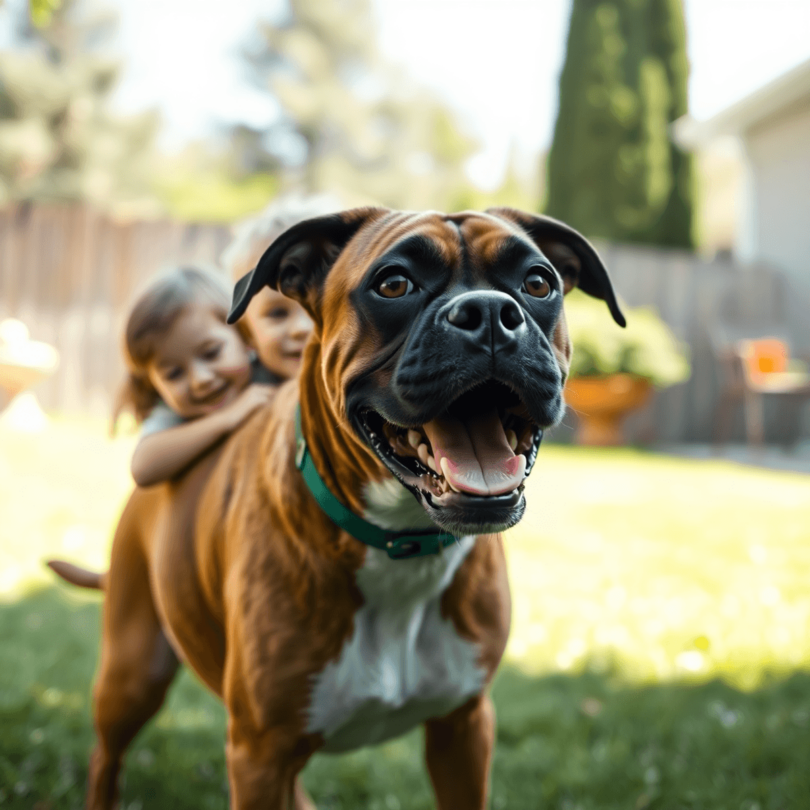The Boxer Dog Breed: Everything You Need To Know
Looking for a furry friend to spice up your family life? The Boxer dog breed might just be the answer! These playful pups have captured the hearts of families around the globe, known for their exuberant spirit and loving nature. Here are some highlights that make Boxers stand out as excellent family companions:
- Loyalty: Boxers are fiercely devoted to their families, providing a sense of security and friendship.
- Playfulness: Their energetic demeanor keeps both kids and adults entertained, turning mundane days into fun-filled adventures.
- Protective Nature: With an inherent instinct to guard, they ensure their loved ones feel safe and sound.
While these traits make Boxers incredibly appealing, potential owners should keep in mind that they require regular exercise and training. To thrive, Boxers need:
- Daily physical activities ranging from 30 minutes to 2 hours
- Consistent training to channel their energy positively
If you’re ready to embrace the joys (and occasional challenges) of owning a Boxer, you’ll find a loyal companion who brings laughter and love into your home.
1. History of the Boxer Breed
The Boxer dog breed has a rich history that traces back to Germany, where it was developed from the Bullenbeisser, a hunting dog known for its strength and tenacity. These early ancestors were used in the 19th century for various tasks, including hunting large game and working alongside farmers.
As the breed evolved, its temperament shifted from a fierce hunter to a loyal companion. In Germany, Boxers gained popularity, becoming essential in both households and as working dogs. Their playful nature and protective instincts made them well-suited for family life.
With the arrival of Boxers in America during the early 20th century, they began to capture hearts across the nation. The American Boxer Club was established in 1935, further solidifying their status as beloved family pets. Recognition by kennel clubs like the American Kennel Club (AKC) and Fédération Cynologique Internationale (FCI) helped legitimize the breed and set standards for appearance and behavior.
Today, Boxer breed information is abundant, reflecting their importance in canine history. Whether you’re seeking a playful companion or a devoted protector, this breed has much to offer.
2. Physical Characteristics of Boxers
Boxers are medium-sized dogs that have a striking appearance. Here’s a closer look at what makes them stand out:
1. Size
Typically, Boxers weigh between 50 to 80 pounds and stand around 21 to 25 inches tall at the shoulder. Their sturdy frame gives them a powerful presence.
2. Coat Colors
The Boxer coat is short and smooth, making it easy to maintain. The most common colors are:
- Fawn: A warm golden hue, often with a black mask.
- Brindle: A unique striped pattern that resembles a tiger’s coat.
- White: A less common but equally charming option; some may have fawn or brindle markings.
3. Distinctive Traits
Boxers are easily recognizable due to their:
- Muscular Build: These dogs boast well-defined muscles, giving them an athletic look suitable for their energetic nature.
- Drooping Ears: Their ears naturally fall down, adding to their expressive and playful demeanor.
These features not only enhance their looks but also reflect their spirited personality and active lifestyle.
While Boxers are popular, it’s interesting to note that there are several rare dog breeds out there, each with its unique characteristics. Additionally, breeds like the Afrikanis showcase the diversity in dog physical characteristics across different breeds.
3. Temperament and Behavior Traits of Boxers
Boxers are the life of the party, known for their playful and energetic nature. These affectionate dogs thrive on interaction, making them fantastic companions for families. Their loyal temperament means they form strong bonds with their humans, often seeking attention and love.
Key characteristics of Boxer temperament include:
- Playfulness: Boxers have an innate sense of fun, loving to chase after toys or engage in games like fetch. Their enthusiasm can bring joy to any household.
- Affectionate Nature: These dogs are known to be cuddly and warm-hearted, often showering their families with love and companionship.
- Protective Instincts: Boxers take their role as family guardians seriously. They will protect loved ones while remaining friendly with those they know.
While Boxers are excellent family pets, proper socialization is crucial. Introducing them to various environments, people, and other pets helps mold well-rounded adults. Consistent training is essential to manage their exuberant behavior—teaching commands and setting boundaries ensures their lively spirit doesn’t turn into unruliness. With patience and dedication, you’ll find that the Boxer temperament can create a loving home filled with energy and loyalty!
4. Exercise Requirements for a Happy Boxer
Boxers are bundles of energy, requiring daily exercise to keep their spirits high and bodies fit. Aiming for 30 minutes to 2 hours of physical activity each day is essential for maintaining their health and happiness. Here’s how you can meet those energetic needs:
1. Daily Walks
Regular walks allow Boxers to explore their environment, socialize, and expend energy.
2. Dog Sports
These playful pups excel in various dog sports such as agility, obedience, and flyball. Engaging in these activities not only satisfies their physical needs but also strengthens the bond between you and your furry friend.
3. Fetch and Tug-of-War
These classic games are perfect for burning off energy while having fun in the process.
Mental stimulation is just as crucial as physical activity. Engaging your Boxer in puzzle toys or training sessions can prevent boredom-induced hyperactivity. You might find some helpful tips and tricks for bored dogs that could assist in this area. Combine different types of exercises to keep things exciting!
By catering to their exercise requirements, you’ll have a happy Boxer who is well-adjusted, loving, and ready for playtime!
5. Training Tips for Your Boxer Dog
Boxers thrive with early training and socialization. Starting young helps them develop into well-rounded companions. Engaging in puppy classes is a fantastic way to introduce your Boxer to various environments, people, and other dogs, laying the groundwork for positive behavior.
Effective Training Techniques
Utilizing positive reinforcement is key to successful training. This approach encourages desired behaviors by rewarding your Boxer with treats, praise, or playtime. Here are some tips:
- Consistency is crucial. Use the same commands and cues to avoid confusion.
- Short sessions work wonders; Boxers have short attention spans. Aim for 5-10 minute training intervals throughout the day.
- Incorporate fun activities like agility drills or fetch, making training feel less like a chore.
Managing Jumping Tendencies
Boxers are known for their exuberance, often jumping up to greet friends or family. To manage this behavior, you can teach “sit” as a default greeting. When your Boxer sits instead of jumping, reward them with affection or treats.
Additionally, you might want to consider implementing some strategies to stop a dog from jumping altogether. Redirect their energy through structured play or obedience drills when they start to leap.
Implementing these training advice and socialization strategies will pave the way for a harmonious relationship with your Boxer while ensuring they display appropriate behaviors at home and in public.
6. Grooming Needs to Keep Your Boxer Looking Great
Keeping your Boxer looking fabulous is a fun and manageable task! With their sleek coat and adorable features, regular grooming helps them shine. Here’s a quick guide to their grooming needs:
1. Brushing Schedule
Aim for weekly brushing sessions. This helps remove loose hair and dirt while promoting a healthy coat. Boxers have short, smooth fur, making this process simple and enjoyable.
2. Bathing Needs
A monthly bath is typically sufficient to keep your pup fresh and clean. Use a gentle dog shampoo that suits their skin type to avoid irritation. If they get particularly muddy or smelly after playtime, feel free to give them an extra rinse!
3. Managing Drooling
Boxers are known for their drool—embrace it! Regularly wipe their mouths with a damp cloth to keep things tidy around the house.
4. Dental Care Tips
Oral hygiene is essential for your Boxer’s overall health. Brush their teeth several times a week with dog-friendly toothpaste. Consider dental chews or toys designed to promote healthy gums and teeth.
With these grooming tips in mind, you’ll ensure your Boxer not only looks great but feels fantastic too!
7. Health Considerations and Lifespan: What Every Boxer Owner Should Know
Owning a Boxer comes with the responsibility of understanding their health needs. Here are some key considerations:
1. Common health problems
Boxers are prone to several conditions, including:
- Hip dysplasia: A genetic condition that affects proper joint formation.
- Cardiomyopathy: A heart condition that can lead to serious complications.
2. Preventative care
Regular veterinary check-ups play a crucial role in catching potential issues early. Vaccinations, dental care, and parasite prevention should be part of routine visits.
3. Understanding specific risks
Boxers have a deep chest, increasing their susceptibility to bloat (gastric dilatation-volvulus). This condition can be life-threatening if not addressed quickly. Signs include restlessness, distended stomach, and unproductive vomiting.
Boxers typically enjoy a lifespan of about 10 to 12 years, but keeping an eye on these health concerns will help ensure your furry friend lives a happy and healthy life. Investing time in their well-being not only enhances their quality of life but also strengthens the bond you share.
8. Feeding Your Boxer: Nutrition Guidelines to Follow
Feeding your Boxer the right way is essential for their health and happiness. Here are some key Boxer diet recommendations to keep in mind:
1. Nutritional Needs by Life Stage
Puppies: Growing Boxers need a diet rich in protein and fat for healthy development. High-quality puppy food is ideal, packed with essential nutrients.
Adults: Once they reach adulthood (around 12 months), transition them to a balanced adult formula. Look for kibble that contains real meat as the first ingredient.
2. Diet Types
High-Quality Kibble: A convenient option with precise nutrient ratios. Ensure it’s grain-free if your Boxer shows sensitivities.
Homemade Diets: Can be beneficial but require careful planning. Consult a vet to ensure all necessary vitamins and minerals are included.
3. Portion Control
Avoid overfeeding by following the guidelines on the food packaging based on your Boxer’s weight and activity level.
Monitor their body condition score regularly to prevent obesity, which can lead to serious health issues.
Providing balanced nutrition is a cornerstone of keeping your Boxer thriving and full of energy!
9. The Boxer as a Family Dog: Is It Right For You?
When it comes to being a family dog, Boxers are truly exceptional! They are incredibly loyal and loving, making them wonderful companions for families.
Benefits of Having a Boxer as a Family Pet:
- Playful Nature: Boxers are known for their energetic spirit, always ready to play fetch or have fun in the yard.
- Protective Instincts: They take their role as guardians seriously, providing an extra layer of security for your family.
- Child-Friendly: With proper socialization, Boxers can be gentle giants with children, forming strong bonds and creating lasting memories.
Considerations for Families:
- Active Lifestyle: Families should be prepared for daily exercise needs ranging from 30 minutes to 2 hours.
- Compatibility with Other Pets: Early socialization is key; Boxers often get along well with other pets when introduced correctly.
Understanding these Boxer dog characteristics helps determine if this breed fits your household. With their playful demeanor and affectionate nature, the question of “Is a Boxer a good family dog?” often receives an enthusiastic yes!
10. Conclusion: Embracing the Joys and Challenges of Being a Boxer Owner
Boxers are a wonderful mix of loyalty, affection, and playfulness. They are energetic and protective, making them great companions. However, owning a Boxer also requires commitment and care.
1. Consider Your Lifestyle
Before bringing a Boxer into your home, take some time to think about your daily routine. Do you have enough time for regular exercise, training sessions, and socialization? These dogs thrive in active environments.
2. Are You Ready?
If you’re prepared to give a Boxer the love, exercise, training, and care they need, they could be the perfect addition to your family!
With the right environment and dedication, Boxers can bring immense joy and fulfillment to your household. Are you ready to embrace the adventure? 🐾
FAQs (Frequently Asked Questions)
What are the key characteristics of the Boxer dog breed?
Boxers are known for their loyalty, playfulness, and protective nature. They make excellent family companions but require regular exercise and training to thrive.
What is the history behind the Boxer breed?
The Boxer breed has German origins and developed from the Bullenbeisser. The breed has historical significance in both Germany and America and is recognized by kennel clubs such as the AKC and FCI.
What are the physical characteristics of Boxers?
Boxers are medium-sized dogs with a muscular build. They typically weigh between 50-80 pounds and stand about 21-25 inches tall. Their coat colors include fawn, brindle, and white, with distinctive drooping ears.
How much exercise does a Boxer need?
Boxers require daily exercise ranging from 30 minutes to 2 hours. Engaging in activities such as dog sports is beneficial, as mental stimulation is important to prevent hyperactivity.
What training tips should I consider for my Boxer?
Early training and socialization are crucial for Boxers. Employ effective techniques such as positive reinforcement to manage behaviors like jumping tendencies and unruliness.
What grooming needs do Boxers have?
Boxers require weekly brushing to maintain their coat, along with monthly baths. It’s also important to manage drooling and provide dental care to keep them healthy.



